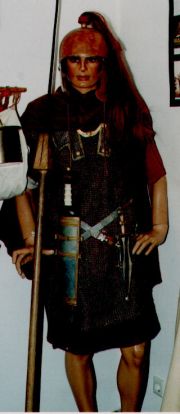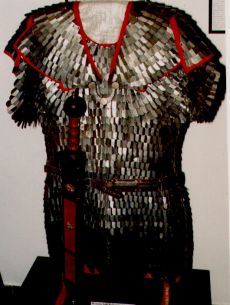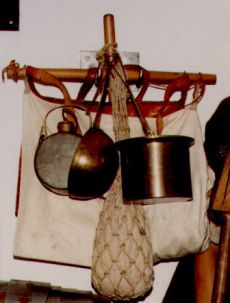
 They were made out of three layers of leather with 90 iron hobnails.
They were made out of three layers of leather with 90 iron hobnails.
 The complete equipment weighed 29 kg, the shield only weighed 10 kg, the chain armour 9 kg.
By the way, these are the clothes and arms of one of the 8 men marching 540 km from Verona to Augsburg over the Brenner Pass in 1985 in remembrance of the Roman expedition over the Alps led by General Drusus and the future Emperor Tiberius.
In those times the Roman fortress in Bonn was built.The reconstruction of the equipment was difficult and expensive. It was bought by two benefactors from Beuel and donated to the museum. In addition to the legionary you can find a scale armour and a plate armour and a reconstruceted ballista (an old weapon for siege warfare).
The complete equipment weighed 29 kg, the shield only weighed 10 kg, the chain armour 9 kg.
By the way, these are the clothes and arms of one of the 8 men marching 540 km from Verona to Augsburg over the Brenner Pass in 1985 in remembrance of the Roman expedition over the Alps led by General Drusus and the future Emperor Tiberius.
In those times the Roman fortress in Bonn was built.The reconstruction of the equipment was difficult and expensive. It was bought by two benefactors from Beuel and donated to the museum. In addition to the legionary you can find a scale armour and a plate armour and a reconstruceted ballista (an old weapon for siege warfare).
 Besides there are more showcases with Roman things, such as tiles with the stamp of the legion I Minerva on it (terra sigillata) or a bowl put together from pieces, 2 golden coins (copies from a gold treasure found in Schwarzrheindorf in the last century), 2 denars and one Nemausus-coin found in Beuel from the time of Octavian, the future Emperor Augustus.
Besides there are more showcases with Roman things, such as tiles with the stamp of the legion I Minerva on it (terra sigillata) or a bowl put together from pieces, 2 golden coins (copies from a gold treasure found in Schwarzrheindorf in the last century), 2 denars and one Nemausus-coin found in Beuel from the time of Octavian, the future Emperor Augustus.
Homepage of Heimatmuseum Beuel